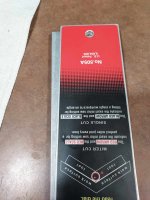I am wondering if anyone has any empirical data (ideally holes in paper) of how much of an effect cant has on accuracy. I found myself missing shots I'd usually make today at the range. The only variable was a lack of a bubble level today. I then borrowed an electronic bubble level to play around with. From *very* little data (prone, steel targets, multiple distances 50-100 yds, 5 shots each), I found myself missing more often when my rifle is canted compared to when it's level. Now I understand that canting your rifle is inevitably less accurate, but I suppose I want to know if I can blame the cant, or my horrible shooting.
Maybe this is very obvious to many of you but I have never played around with or learned much about cant before and always used a bubble level (until today).
The red part of the angle finder represents a 2 deg cant, if you are on level ground, highly noticeable.

I am going to babble like a fool here. If you are shooting groups at 100 yards, all shots fired need to be with the same cant. with level being optimum.
First, your average accuracy at 100 needs to be defined. If your target size is 1.5" and your rifle avg's 1.1", a miss could be anything. Now if the target is 3", you'd need a fair amount of cant to miss, all things equal.
I tend to lift my bolt too hard, and impart some left tilt, not shooting 1/4" dots on paper, but with the targets I shoot, I really can never blame cant. I doubt I will ever shoot paper at 100, but will try on steel someday, knowing full well, spot on spot accuracy won't be there.
Even out to 300 yards, which of course there has to be some distance where too many other things play, but don't
see it there either.
One would think with what we know with CF cases, a slow 22LR bullet should exhibit the same or more deflection. I just don't see it much, if all, but if I miss and notice that I have the rifle canted, I don't readjust to level, just make the correction I see.
I don't own a bubble level at the moment, but never used to take a shot over 500 yards w/o using one. It sounds like you want one, by all means get one, you'll solve this puzzle yourself. But I must ask, did the borrowed level actually make you pay more attn to your total position when breaking the shot?
Like pmclaine says, we are programmed for level, and with my pic, no one would hang a picture with even a 1 deg cant, unless to purposely piss the little woman off.

